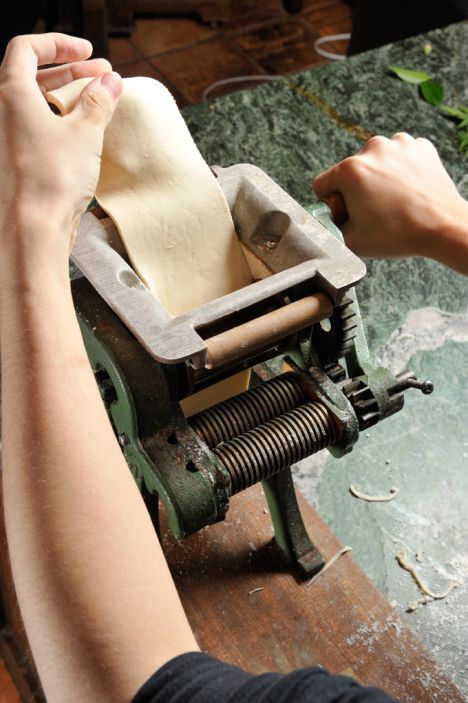Teuchi Ramen
Serves 4
Tadaaki usually makes the ramen at our house, but I go for a simpler method and have slashed and burned his here. David Chang’s it is not, but we cannot all follow the Momofuku ramen method, so keep in mind the basic idea and experiment from there.
I like to make stock from the leftover bones of chickens I have roasted whole, stuffed with garden thyme branches and quartered lemons. Our chickens are so sublime that I add nothing but water along with the thyme sprigs and drippings off of the cutting board. I tried to cook the soup all night, but the gas alarm company called my mother-in-law in the middle of the night, and she crept upstairs to wake my husband. He has now nixed the overnight cook method. This deeply flavorful chicken soup makes an unforgettable ramen broth for homemade ramen (though not strictly orthodox). Also a dab of any reserved pan juices in each bowl adds extra complexity to the homemade ramen.
Broth
2 small carrots, cut into 1-inch (2.5-cm) lengths
2 small negi (Japanese leeks) or spring onions, cut into 1-inch (2.5-cm) lengths
1 (3/4-inch/2-cm) knob fresh ginger, peeled and finely sliced
4 free-range chicken thighs, bone-in (or 8 wings)
1 teaspoon sea salt
2 tablespoons best-quality rapeseed or sesame oil
Noodles
2 tablespoons sesame oil
2 cups (300 g) good-tasting all-purpose flour
2 large eggs, at room temperature
2 egg yolks, at room temperature
Toppings
4 9-minute boiled eggs, cooled in an ice bath
1 small bunch boiled, squeezed, and chopped bitter greens (bok choy or komatsuna
3 tablespoons finely chopped negi (Japanese leeks) or scallions
1 sheet nori, cut into eighths
Rayu (chile-infused sesame oil), for serving (optional)
Yuzu Kosho, for serving (optional)
Flavorings
Miso
Soy sauce
Sea salt
Start the ramen soup early in the day or at least several hours before dinner.
Heat the oven to 450oF (235oC). Put the carrots, negi, ginger, and chicken thighs in a cast-iron pan, and sprinkle with the salt and oil. Smoosh the oil around to coat all the chicken and vegetables and roast for 30 to 45 minutes in the middle of the oven.
Scrape the roasted chicken and vegetables and all of the pan drippings into a large heavy pot with 4 quarts (4 liters) of cold water and bring to a boil over high heat. Lower the heat and simmer, covered, for 1 hour. Uncover, pull out 2 thighs, place in a medium-sized bowl, and ladle a bit of broth over to allow the meat to cool gently. Simmer the stock, uncovered, for 1 hour more. If you are in a hurry, use half the amount of water and cook in a pressure cooker. (In Japan, meat is usually not sold on the bone, so Tadaaki uses chicken wings. N.B.: Most ramen shops use pork bones as the base to their broth, though chicken bones and dried fish usually play some role as well.)
After the chicken meat has cooled for a half hour, shred, moisten with a ladle of broth, and reserve. When the stock is done, strain into a clean saucepan and keep warm over low heat.
Prepare the ramen noodle dough by mixing 2 tablespoons of the sesame oil into the flour with your fingers until crumbly. Add the eggs and egg yolks and stir with your hand until just incorporated. Knead on a clean, flat surface for 5 minutes until pliable but stiff. Let the dough rest while you prepare the ramen toppings.
Fill the largest stockpot you own with hot water and bring to a boil over high heat.
Roll out with a pasta machine, making rectangles about 2 feet (60 cm) long and a little thinner than the 1/8 inch (3 mm) thick. Cut the noodles on the thin linguine setting and cut into 8-inch (20-cm) lengths with a pizza cutter. Flour well, and toss to distribute the flour. Leave on the workspace, but do not clump into a mass.
Alternatively, roll out into a rough oblong shape on a counter surface with a 30-inch (75-cm) long dowel 1 1/2 inches (3 cm) in diameter. Roll from the center out, periodically rolling the dough around the dowel to keep from sticking on the counter. When the dough has
reached the desired thickness, roll it around the dowel, slide the dowel out, and gently flatten the roll of dough to cut. Slice into a bit thinner than 1/8-inch (3-mm) strips with a broad-bladed, razor-sharp knife.
Take out a large soup bowl per person and add seasoning to each bowl according to each person’s desire: 1 tablespoon miso, 2 teaspoons soy sauce, or 1/2 teaspoon salt. Mix a little broth in to melt the salt or emulsify the miso. Distribute the reserved shredded chicken pieces among the bowls along with the small amount of broth in which it was cooled.
Boil the noodles for 2 minutes and right before the noodles are done, add 2 or 3 ladlefuls of broth to the bowls. Set a large strainer in a bowl and after 2 minutes has elapsed, scoop the noodles out of the boiling water with a small fine-mesh strainer and drop into the large strainer. Divide the noodles among the bowls filled with soup and quickly add 2 egg halves, a dollop of greens, and a piece of nori before sprinkling liberally with the negi. Serve immediately. If you are doubling (or tripling) the recipe, do not be tempted to cook more than 4 portions at a time. Continue cooking more noodles but the first four people served should dive in, otherwise the noodles will inflate beyond control!
If added spice is desired, drizzle soy sauce or miso ramen with rayu and dab salt ramen with yuzu kosho.
Variations: You can also substitute semifresh ramen noodles (sometimes found at Japanese or Chinese grocery stores) or dried. Follow the directions on the package for cooking. They will not be as good.

